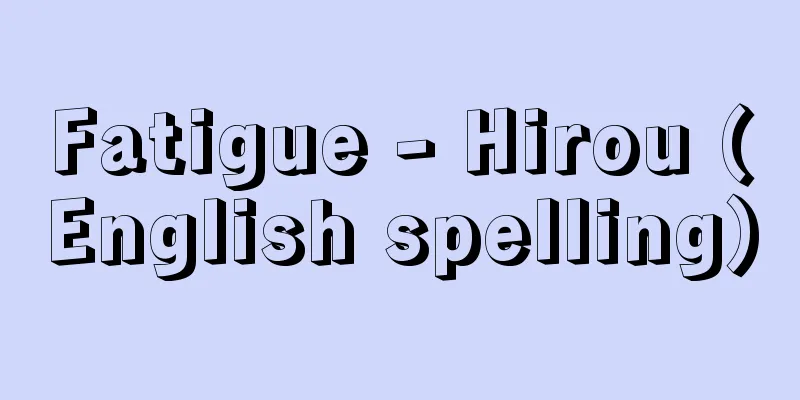Fatigue - Hirou (English spelling)

|
Fatigue is a state in which the ability to exercise or work is reduced as a result of continued exercise or work. In our daily lives, we often use the words "physical fatigue" and "mental fatigue," but there are various factors that cause these, and to date, the true nature of fatigue has not yet been clarified. There are many theories proposed to explain the cause of fatigue, such as the theory that fatigue substances accumulate in the body through activity (fatigue substance theory), the theory that the regulatory mechanism of hormones, especially adrenal cortical hormones, breaks down due to stress from the outside world (stress theory), and the theory that fatigue is a state in which the organic relationships between organs and tissues, which normally function in a purposeful manner in conjunction with each other (dysfunction theory), are disrupted. However, while each of these theories can explain one aspect of fatigue, they cannot explain the overall cause and mechanism of the fatigue we experience in our daily lives. [Hidenobu Mashima] Physical and mental fatigueAs mentioned before, fatigue can be broadly divided into physical fatigue and mental fatigue. Physical fatigue is mainly caused by muscle (skeletal muscle) fatigue as a result of physical exercise. In an experiment, when skeletal muscle of a frog or other animal excised from the body is electrically stimulated at a frequency of about once per second, the muscle contraction height increases for the first few times, but then gradually decreases, and finally it does not contract at all no matter how strong the stimulation. This is called muscle fatigue. The cause of muscle fatigue is a decrease in the energy source, but more than that, it is due to a decrease in the hydrogen ion concentration (pH) inside the muscle caused by lactic acid generated as a result of a lack of oxygen in the muscle, which causes a general slowdown in metabolism. In addition, muscle contraction force may decrease as a result of impulse transmission at the junction between the nerve fiber and the muscle, i.e., the neuromuscular junction (this is called transmission fatigue). Physical fatigue is thought to be caused by a complex interaction of numerous factors throughout the body, including the accumulation of metabolic products such as ketone bodies and urobilinogen, decreased carbohydrate utilization due to decreased adrenaline secretion, and a decrease in the oxygen diffusion rate in the capillary walls. On the other hand, mental fatigue appears when monotonous tasks are repeated or when highly intellectual tasks are performed for a long period of time. However, unlike physical fatigue, it is difficult to judge because there are no clear physiological changes and there are large individual differences. In addition, when you are mentally fatigued, the activity of the neocortex decreases, and it is thought that the hypothalamus plays an important role in this. Furthermore, when it comes to mental fatigue, the psychological aspect cannot be overlooked. When you are satisfied with your work and are motivated, you are unlikely to feel tired, but it is common to experience a sudden feeling of fatigue when you fail at a job. In addition, while physical fatigue is sometimes accompanied by a pleasant feeling (pleasant fatigue), the hypothalamus is closely related to the limbic system, which regulates our emotions, so mental fatigue is usually accompanied by unpleasant feelings, making you irritable or depressed. If mental fatigue becomes chronic, it can cause emotional instability and neurotic symptoms. [Hidenobu Mashima] Subjective fatigue, objective fatigue, physiological fatigueFatigue can also be classified into subjective, objective, and physiological fatigue. Subjective fatigue is a subjective symptom felt only by the individual, and unique symptoms such as "I'm tired," "I feel heavy," and "I want to rest" appear. It is currently impossible to objectively measure or evaluate the degree of subjective fatigue, that is, the strength of each symptom, but it is thought to be a kind of warning to prevent excessive vital activity. On the other hand, the psychological effects of subjective fatigue cannot be ignored, and even if the feeling of fatigue is severe, the feeling of fatigue may disappear when work that interests the individual begins or an emergency occurs. Objective fatigue can be recognized as a decrease in the amount and quality of work. When strenuous exercise is continued, muscle fatigue reduces athletic ability. This type of fatigue can be objectively evaluated by measuring muscle strength before and after exercise. Furthermore, when simple calculations are performed over an extended period of time, calculation speed decreases over time, while the rate of errors gradually increases. This is due to mental fatigue, and the degree of fatigue can be evaluated by calculation speed and error rate. Physiological fatigue is muscle fatigue, fatigue of nerve transmission, and a qualitative decline in various bodily functions, and can be most accurately evaluated using various measuring instruments. Information used to determine fatigue includes biochemical changes such as blood specific gravity, erythrocyte sedimentation rate, and excretion of sugar and protein in urine, as well as physiological changes such as respiratory rate, heart rate, and blood pressure. However, these have the disadvantage of being easily affected by dietary content and other factors. The flicker test is the most commonly used method for measuring fatigue. When a stimulus light is switched on and off regularly at a certain frequency, it creates a flickering sensation. However, when the frequency exceeds a certain number, the flickering merges and is perceived as a continuous light. The minimum frequency at which this occurs is called the "critical fusion frequency" or "flicker value." Flicker values vary greatly depending on the intensity of the light, but when measurements are taken before and after work under constant conditions, the flicker value decreases after the work compared to before the work. In other words, even light that flickers at a relatively low frequency cannot be perceived as flickering, and is perceived as a continuous light. This is thought to be due to a decrease in the activity level of the cerebrum caused by fatigue, and it is a convenient method for quantitatively expressing the degree of fatigue. Incidentally, the three types of fatigue mentioned above do not exist separately, but usually all three appear at the same time. Of these, subjective fatigue is the most sensitive. In the case of subjective fatigue, even if the person feels tired, it may not be possible to detect the fatigue at all from the outside. This is not because the feeling of fatigue is simply determined by a psychological issue (mental state), but because our bodies are far superior detectors of fatigue than the measuring devices we use. [Hidenobu Mashima] Dealing with fatigueThe most effective way to deal with fatigue is rest and sleep. Of course, everyone knows that "if you are tired, you should rest," and everyone does so, but it is difficult to judge how tired you are and how long you need to rest. In the case of physical fatigue, the individual can tell the degree of fatigue by the weakening of muscles and the increase in pulse rate, and can determine whether or not rest is necessary. However, mental fatigue varies greatly from person to person, and there are no clear symptoms to determine the degree of fatigue. In particular, important but monotonous and long-lasting work such as monitoring instruments can cause severe mental fatigue and the risk of making errors increases over time. In such cases, it is desirable to decide on a certain amount of time to rest. Fatigue accumulated during a day's work can be recovered by returning home, resting, and sleeping. It is best not to carry over fatigue from a day to the next day, but depending on the type of work, fatigue may not be recovered from on the same day and may gradually accumulate. In order to prevent such fatigue from becoming chronic, it is very reasonable to rest every seventh day, that is, on Sundays. It is also said that in order to recover from fatigue, it is more effective to rest the tired parts of the body as much as possible while keeping other parts active, rather than simply resting and doing nothing. In fact, it has been reported that if your right hand becomes tired from work, working your left hand will help the right hand recover more quickly than resting and doing nothing (the Sechenos effect). For the same reason, if you are tired from mental work, doing some light sports on your days off, and if you are tired from physical labor, spending your days off relaxing by reading or enjoying a hobby will be more effective in recovering from fatigue. [Hidenobu Mashima] Source: Shogakukan Encyclopedia Nipponica About Encyclopedia Nipponica Information | Legend |
|
運動や作業を続けた結果としてそれらの能力が低下した状態を疲労という。日常われわれは「身体的疲労」「精神的疲労(心的疲労)」ということばをよく口にするが、それらをおこす要因はさまざまであり、現在までのところ、疲労の本態はまだ明らかにされていない。疲労がおこる原因の説明として、活動によって体内に疲労物質が蓄積するという説(疲労物質説)、外界から加わったストレスによってホルモン、とくに副腎(ふくじん)皮質ホルモンによる調節機序(メカニズム)が破綻(はたん)するとする説(ストレス学説)、あるいは、身体の各部分は通常相互に関連しあって合目的的な活動を行っているが、疲労はそのような各臓器・組織の有機的関連が乱れた状態であるとする説(機能失調説)など、多数の学説が提唱されている。しかし、これらの学説は、どれも疲労の一面を説明することはできても、われわれが日常経験する疲労の成因、その機序を全体として説明しうるものではない。 [真島英信] 身体的疲労と精神的疲労疲労には、前に述べたように大きく分けて身体的疲労と精神的疲労とがある。身体的疲労は、肉体的運動の結果、主として筋(骨格筋)が疲労することによっておこるものである。実験的に体外に切り出したカエルなどの骨格筋を、1秒間に1回程度の頻度で電気刺激すると、筋の収縮高は初めの数回は増大するが、その後しだいに減少し、ついにはいくら刺激を強くしてもまったく収縮しないようになる。これが筋疲労とよばれるものである。筋疲労の原因は、エネルギー源の減少にもよるが、それよりもむしろ、筋の酸素不足の結果発生する乳酸によって筋肉内部の水素イオン濃度(pH)が低下し、代謝が全般に遅くなることによっている。また、神経線維と筋との連絡部、すなわち、神経筋接合部における刺激伝達がうまくいかなくなった結果として筋の収縮力が低下する場合もある(これを伝達疲労という)。身体的疲労は、全身的にはケトン体、ウロビリノーゲンなどの代謝産物の蓄積、アドレナリン分泌の低下による糖質利用の低下、毛細血管壁の酸素拡散速度の減少など、多数の要因が複雑に関係しあって生じると考えられている。 一方、精神的疲労は、単調な作業の繰り返しや、高度な知的作業を長時間続けたときに出現するが、身体的疲労とは異なり、はっきりとした生理的変化が現れないし、個人差も大きいため、その判定は困難である。また、精神的疲労時には大脳新皮質の活動性が低下するが、これには視床下部が重要な役割を果たしていると考えられている。さらに精神的疲労に関しては、心理的側面も見逃すことはできない。仕事に満足し、それに意欲を燃やしているときには疲労感は生じにくいが、仕事に失敗したとたんに疲労感に襲われることはしばしば経験することである。また、身体的疲労では、ときとして快感(心地よい疲れ)を伴うのに対し、視床下部はわれわれの感情を調節している大脳辺縁系とも密接に関連しているため、精神的疲労では、通常、不快感を伴い、怒りっぽくなったり、気分がめいったりするようになる。精神的疲労が慢性化すると、情緒の不安定、ノイローゼ症状をきたすこともある。 [真島英信] 主観的疲労・他覚的疲労・生理的疲労疲労はまた、主観的疲労、他覚的疲労、生理的疲労に分類することもできる。主観的疲労は本人のみが感じる自覚症状であり、「疲れた」「体がだるい」「休みたい」といった独特の徴候が出現する。このような主観的疲労の程度、すなわち各症状の強さを客観的に測定・評価することは現在のところ不可能であるが、これは生命活動の行きすぎを防止するための一種の警報であると考えられる。一方、主観的疲労においては、心理的影響も無視できず、疲労感の甚だしい場合でも、自分が興味をもっている仕事が始まったり、緊急事態が発生すると、疲労感が消失してしまうことがある。 他覚的疲労は、作業量およびその質の低下として認めることができる。激しい運動を続けた場合には、筋の疲労によって運動能力は低下する。こうした疲労は、運動前後の筋力を測定することによって客観的に評価することができる。また、簡単な計算を長時間続けると、計算速度は時間とともに低下し、逆に誤りの割合はしだいに上昇する。これは精神的疲労によるものであり、計算速度や誤りの率によって疲労の程度を評価することができる。 生理的疲労は、筋疲労、神経伝達の疲労、その他身体諸機能の質的低下であり、種々の測定器具によってもっとも正確に評価することができる。疲労の判定に利用される情報としては、血液の比重、血沈、尿中への糖やタンパクの排泄(はいせつ)などの生化学的変化と、呼吸数、心拍数、血圧などの生理学的変化があげられる。しかし、これらは食事内容その他の影響を受けやすいという欠点をもっている。 疲労の測定にもっともよく用いられるのが、フリッカーflicker(ちらつき)検査である。刺激光を一定の頻度で規則正しく遮断して明滅させると、ちらつきの感じを生ずる。しかし、頻度が一定数以上になると、ちらつきは融合して持続的な光として感じられるようになる。このようになる最小頻度を「臨界融合頻度」または「フリッカー値」という。フリッカー値は、光の強さによっても大きく異なるが、条件を一定にした作業の前後で測定を行ってみると、作業後には作業前に比べてフリッカー値が低下する。すなわち、比較的低頻度の光の明滅でもちらつきを感じることができず、持続的な光として感じられるようになるわけである。これは、疲労によって大脳の活動水準が低下したためであると考えられ、疲労の程度を定量的に表す方法としては便利なものである。 ところで、前述した3種類の疲労は、それぞれが別個に存在するものではなく、通常は三者が同時に出現するものである。このなかで、もっとも感度の高いのが主観的疲労である。主観的疲労の場合は、本人に疲労感があっても、外部からはまったくその疲労を検知できないこともある。これは、疲労感が単なる心理的な問題(心の持ちよう)で決まるためではなく、われわれの用いる測定器具よりも、われわれの身体のほうが数段優れた疲労の検出器であるためと考えられる。 [真島英信] 疲労への対処疲労に対処するもっとも有効な手段は、休息と睡眠である。「疲れたら休む」ということは、当然だれもが知っており、かつ実行していることであるが、どの程度疲れたら、どのくらい休む必要があるかという判定は困難である。身体的疲労の場合は、筋力の低下、脈拍数の増加などによって本人も疲れの程度がわかり、休息の要・不要を判定することができる。しかし、精神的疲労に関しては個人差が大きく、かつ疲労の程度を判定するためのはっきりとした症状がない。とくに計器の監視作業のように、重要ではあるが単調かつ長時間にわたる作業では、精神的疲労が激しく、時間とともに誤りを犯す危険が上昇する。このような場合には、一定の時間を決めて休息することが望ましい。1日の仕事によってたまった疲労は、帰宅して休息し、睡眠をとることによって回復する。1日の疲れは翌日に持ち越さないことがもっとも望ましいが、仕事の内容によっては、その日のうちには疲労から回復せず、しだいに疲労が蓄積することがある。このような疲労の慢性化を防ぐうえでは、7日目ごと、すなわち日曜日に1日休息することは非常に合理的である。また、疲労からの回復のためには、ただ単に何もしないで休むよりも、身体の疲労した部分はできるだけ休ませつつ、逆に他の部分を活動させるほうが効果があるといわれている。実際に、たとえば作業によって右手が疲労した場合は、何もしないで休息するよりも、左手を働かせていたほうが右手の疲労の回復が速いという報告が出されている(セチェーノス効果)。同様の理由から、精神作業によって疲労した場合は休日には軽いスポーツを行い、肉体労働によって疲労した場合は休日をのんびりと読書や趣味で過ごすことが、疲労の回復には有効となる。 [真島英信] 出典 小学館 日本大百科全書(ニッポニカ)日本大百科全書(ニッポニカ)について 情報 | 凡例 |
<<: Livistona chinensis R.Br.var.subglobosa Becc.
Recommend
Ishihara Color Blindness Test Chart - Ishihara Color Blindness Test Chart
…He studied in Germany, and in 1922, while still ...
Kusaie
Kosrae is a volcanic island in the eastern part o...
Bothrops alternatus (English spelling)
… [Takahiro Matsui]. … *Some of the terminology t...
backstage
...In most cases, it is located at the back or re...
Benefits Lawsuit - Kyufusosho
A lawsuit in which the plaintiff alleges the exist...
enchaînement (English spelling)
…It can also refer to a dance accompanied by alle...
Junshu - Junshu
A rich, cloudy sake. Also, a pure sake. Source: Ab...
Glaciology
...Alternative: Wegener and HW Ahlmann are two of...
Nobutaka Yoshitsugu - Nobutaka Yoshitsugu
...Years of birth and death unknown. Also known a...
Scrofulosis
…In slang, it has been used to mean a weak consti...
black-eyed-Susan vine
...The scientific name of the genus is derived fr...
Yoshio Kitahara
…Art magazine. It was first published in April 19...
Caraka
...According to this, the king initially disdaine...
Kaida Plateau
(Kiso Town, Kiso District, Nagano Prefecture) A to...
Moguriga (Minor Moth) - Moguriga
Some moth larvae burrow into the leaves, fruits, s...






![Caucasus [mountain range] - Caucasus](/upload/images/67cb3ca31ebbc.webp)


